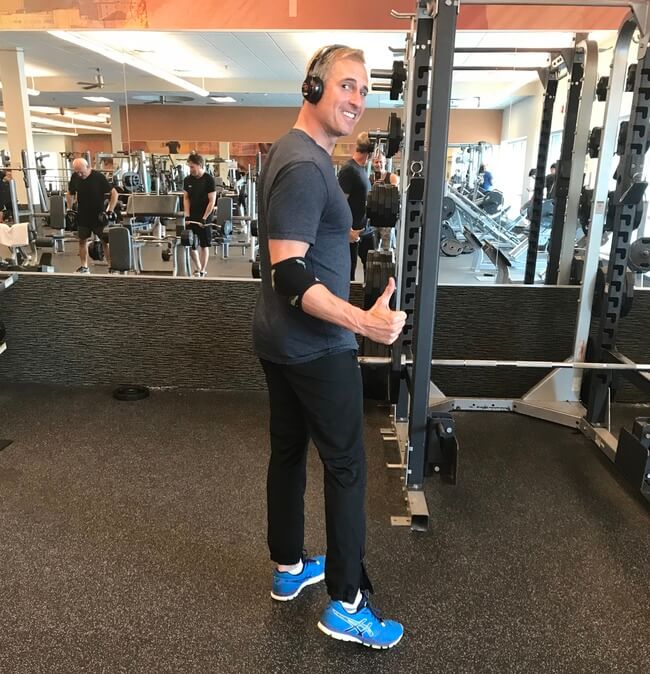
Working from home looks a bit different for our animal companions than it does for us humans. Image courtesy Bruno Cervera on Unsplash.
How are you faring? Here in California, we’re still squarely in shelter-in-place mode, perhaps settling into “normal-for-now.” Some people, whose professions allow it and who didn’t already work remotely, are still acclimating to the experience of working from home full-time. How can we optimize our home work environments?
Not long ago, I had a discussion with a friend of mine who’s a full-time writer: let’s call him “Adrian.” Adrian recently decided to have someone build him a new writing desk to specs, and was curious to get my posture-aware take on how to make sure his new desk, and home working environment more generally, can be supportive of healthy posture.
You may wonder what gives me license to answer these questions in the first place. I’m a posture educator and creator of the Gokhale Method. Through learning and applying healthy posture habits, I was able to rid myself of debilitating back pain, avoid a second back surgery, have two more children than my doctors thought advisable, and remain pain-free and productive for decades.
What’s the best desk height?
Adrian’s first concern is desk height. His laptop is a smallish one with a 13-inch display, so the screen doesn’t extend very high up from a desk surface. His existing desk feels low to him and is 29 inches tall. From what he’s found, the industry standard is 29-30 inches. He wanted to know whether 29 inches is too low or if he needs a taller desk, especially if he’s working with a relatively low screen height to begin with. Put another way: if someone has a smaller display, do they then need a desk which compensates by being 31 or 32 inches tall?
My take: as long as the screen doesn’t induce your upper body to curve forward, it’s fine to have your screen lower than your eye level. Your eyes are perfectly capable of looking down to that degree without causing strain. The key thing is not a number, but rather what is happening in your body. Some people use floor-sitting desks that are only 6 inches off the ground perfectly well because they have good form while doing so. A custom-height desk as tall as 31 or 32 inches off the ground isn’t necessary unless it’s for comfort.

How high should my monitor be?
Adrian was also worried about monitor height. A prevalent idea seems to be that eye level is the right level for a monitor. In line with that way of thinking, he wanted to know whether the screen being 2 or 3 inches below eye level is an active problem. With his current desk height, he has to look slightly down at his display while writing. Should Adrian be worried about the possibility of neck and back strain if he’s looking down that much and for that long?
From my perspective, that slight degree of looking down at a monitor sounds perfect, actually. Think hunter-gatherer: the line of vision would slant down since you have to be looking for animal tracks, signs of buried tubers, and watching where you step. Our bodies are perfectly capable of this behavior as they’ve been doing it for millennia.
90-degree knees?
Adrian has heard that his knees should create a 90-degree angle while sitting. Is this true?
Even with all my background in posture and posture research, there’s no research I know of that supports this. People like round numbers, straight lines, and even divisions (in some cultures, anyway), and just shoehorn them into whatever topic they may be discussing, even if such numbers rarely exist in the complexity of nature and biology — parallel lines, 90-degree angles, etc. This reminds me for some reason of how rhino horns are supposed to be an aphrodisiac.
Humans are skilled at pattern recognition, which sometimes predisposes us to make conceptual leaps not grounded in fact when we see patterns and connections that aren’t really there (case in point: the rhino horn example). In any case, worrying about human knees always being at a 90-degree angle while seated is not really a concern of mine. In fact, externally rotating the legs is a more constructive goal, and one among many other posture nuggets you can learn to achieve in our courses.
It’s also worth mentioning that, for seated desk work, the chair we painstakingly designed (and which Adrian uses!) is both conducive to good posture and extremely durable. Mine is 10 years and still in great repair.

Keyboard placement: what’s the right distance?
Keyboard distance is also a concern for Adrian, as he wants to calibrate his desk setup fairly precisely. From my viewpoint, it’s very important that you be able to come in close to the keyboard. Though your arms are certainly capable of reaching out to a more distant keyboard, this takes more muscular effort. If you have the choice, come in super close — the feeling wants to be almost like you’re surrounded by your desk or as though you’re in a cockpit. When the keyboard is further away, this can easily play into old habits of curving the upper back forward, craning the neck forward, or displacing the shoulders forward, all of which compromise the body.
Standing desks: what’s the best approach?
For many people working remotely, options for standing desks or alternate workspaces are tremendously appealing as a way to get a break from the same old seated posture and work location around the house. Adrian wants to fashion a standing workspace out of his new seated desk. He figures he’ll probably get an additional place-on-top appliance to make the desk work for standing as well as sitting.
Here’s what I do to make a standing workspace: I use a simple wooden footstool on top of my massage table when I want a standing desk — I just place my laptop on the stool and work away.

Sometimes my Congolese drum can be useful too, but it’s not really stable enough. Whatever you use doesn’t have to be formal — just a nice height.

The home work space posts on the Twitter thread started by @julesforrest illustrate this nicely.



Whatever your creative desk arrangement, make sure you use healthy posture while standing — the posture technique known as tallstanding comes to mind. Get creative and experiment: changing your work location and/or position can inject a fresh burst of energy into your day.
Give it a try!


